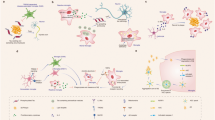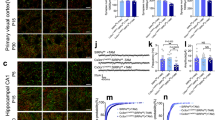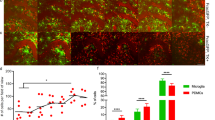Abstract
Microglia, the immune cells of the brain, can have a beneficial effect in Alzheimer's disease by phagocytosing amyloid-β. Two-photon in vivo imaging of neuron loss in the intact brain of living Alzheimer's disease mice revealed an involvement of microglia in neuron elimination, indicated by locally increased number and migration velocity of microglia around lost neurons. Knockout of the microglial chemokine receptor Cx3cr1, which is critical in neuron-microglia communication, prevented neuron loss.
This is a preview of subscription content, access via your institution
Access options
Subscribe to this journal
Receive 12 print issues and online access
$209.00 per year
only $17.42 per issue
Buy this article
- Purchase on Springer Link
- Instant access to full article PDF
Prices may be subject to local taxes which are calculated during checkout

Similar content being viewed by others
References
Nimmerjahn, A., Kirchhoff, F. & Helmchen, F. Science 308, 1314–1318 (2005).
Hanisch, U.K. & Kettenmann, H. Nat. Neurosci. 10, 1387–1394 (2007).
Grathwohl, S.A. et al. Nat. Neurosci. 12, 1361–1363 (2009).
Wyss-Coray, T. Nat. Med. 12, 1005–1015 (2006).
London, J.A., Biegel, D. & Pachter, J.S. Proc. Natl. Acad. Sci. USA 93, 4147–4152 (1996).
Giulian, D. et al. J. Neurosci. 16, 6021–6037 (1996).
Oddo, S. et al. Neuron 39, 409–421 (2003).
Fuhrmann, M. et al. J. Neurosci. 27, 6224–6233 (2007).
Harrison, J.K. et al. Proc. Natl. Acad. Sci. USA 95, 10896–10901 (1998).
Chapman, G.A. et al. J. Neurosci. 20, RC87 (2000).
Bolmont, T. et al. J. Neurosci. 28, 4283–4292 (2008).
Cardona, A.E. et al. Nat. Neurosci. 9, 917–924 (2006).
Dénes, A. et al. J. Cereb. Blood Flow Metab. 28, 1707–1721 (2008).
Davalos, D. et al. Nat. Neurosci. 8, 752–758 (2005).
Jung, S. et al. Mol. Cell. Biol. 20, 4106–4114 (2000).
Acknowledgements
We thank S. Oddo for generously providing the 3xTg-AD mice and P. Thevnaz and E. Meijering for the development of the ImageJ plugins stackreg and MTrackJ. This work was supported by grants from the Deutsche Forschungsgemeinschaft (SFB 596, A13), the German Federal Ministry of Education and Research (Bundesministerium für Bildung und Forschung, 01GZ0713, 13N9268), the German Federal Ministry of Economics and Technology (Bundesministerium für Wirtschaft und Technologie, 16IN0675) and the European Union (Neuro.GSK3, FP-7-223276).
Author information
Authors and Affiliations
Contributions
M.F. and T.B. conducted the experiments and wrote the manuscript. C.K.E.J. and S.B. provided technical assistance. R.M.P. performed Aβ measurements. G.M., H.K., C.H. and F.M.L. provided mouse models and helpful discussion. J.H. coordinated the research and supervised the project.
Corresponding author
Ethics declarations
Competing interests
The authors declare no competing financial interests.
Supplementary information
Supplementary Text and Figures
Supplementary Figures 1–5 and Supplementary Methods (PDF 4731 kb)
Supplementary Video 1
Example of a z stack acquired by two-photon in vivo imaging. Z stack from 650 μm depth to the surface in a living mouse brain. Neurons are labeled with YFP and microglia with GFP. (MOV 3683 kb)
Supplementary Video 2
Tracking of microglia migration in vivo. 5-week time-lapse example of microglia migration around a neuron. Colored lines representing the tracks of the microglia are superimposed. (MOV 1518 kb)
Supplementary Video 3
Screening behavior of microglia with extension and retraction of fine processes. The video consists of z stack projections (40 μm) of fluorescence images recorded with a time interval of 5 min 150 μm below the brain surface. (MOV 1826 kb)
Supplementary Video 4
Turnover rate (TOR) of microglia. Red/green overlay of subsequent time points to visualize gained (green) and lost (red) as well as stable (yellow) areas of microglial processes. (MOV 1623 kb)
Rights and permissions
About this article
Cite this article
Fuhrmann, M., Bittner, T., Jung, C. et al. Microglial Cx3cr1 knockout prevents neuron loss in a mouse model of Alzheimer's disease. Nat Neurosci 13, 411–413 (2010). https://doi.org/10.1038/nn.2511
Received:
Accepted:
Published:
Issue Date:
DOI: https://doi.org/10.1038/nn.2511
This article is cited by
-
Long-term oral administration of curcumin is effective in preventing short-term memory deterioration and prolonging lifespan in a mouse model of Alzheimer’s disease
Advances in Traditional Medicine (2024)
-
Tau and neuroinflammation in Alzheimer’s disease: interplay mechanisms and clinical translation
Journal of Neuroinflammation (2023)
-
Molecular subtypes of ALS are associated with differences in patient prognosis
Nature Communications (2023)
-
Effect of Proinflammatory S100A9 Protein on Migration and Proliferation of Microglial Cells
Journal of Molecular Neuroscience (2023)
-
Nicotinamide reverses deficits in puberty-born neurons and cognitive function after maternal separation
Journal of Neuroinflammation (2022)



